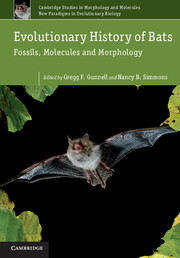Book contents
- Frontmatter
- Contents
- Contributors
- Preface
- 1 Phylogenies, fossils and functional genes: the evolution of echolocation in bats
- 2 Systematics and paleobiogeography of early bats
- 3 Shoulder joint and inner ear of Tachypteron franzeni, an emballonurid bat from the Middle Eocene of Messel
- 4 Evolutionary history of the Neotropical Chiroptera: the fossil record
- 5 New basal noctilionoid bats (Mammalia: Chiroptera) from the Oligocene of subtropical North America
- 6 Necromantis Weithofer, 1887, large carnivorous Middle and Late Eocene bats from the French Quercy Phosphorites: new data and unresolved relationships
- 7 African Vespertilionoidea (Chiroptera) and the antiquity of Myotinae
- 8 Evolutionary and ecological correlates of population genetic structure in bats
- 9 A bird? A plane? No, it's a bat: an introduction to the biomechanics of bat flight
- 10 Toward an integrative theory on the origin of bat flight
- 11 Molecular time scale of diversification of feeding strategy and morphology in New World Leaf-Nosed Bats (Phyllostomidae): a phylogenetic perspective
- 12 Why tribosphenic? On variation and constraint in developmental dynamics of chiropteran molars*
- 13 Necromantodonty, the primitive condition of lower molars among bats
- 14 Echolocation, evo-devo and the evolution of bat crania
- 15 Vertebral fusion in bats: phylogenetic patterns and functional relationships
- 16 Early evolution of body size in bats
- Index
- Plate section
- References
13 - Necromantodonty, the primitive condition of lower molars among bats
Published online by Cambridge University Press: 05 June 2012
- Frontmatter
- Contents
- Contributors
- Preface
- 1 Phylogenies, fossils and functional genes: the evolution of echolocation in bats
- 2 Systematics and paleobiogeography of early bats
- 3 Shoulder joint and inner ear of Tachypteron franzeni, an emballonurid bat from the Middle Eocene of Messel
- 4 Evolutionary history of the Neotropical Chiroptera: the fossil record
- 5 New basal noctilionoid bats (Mammalia: Chiroptera) from the Oligocene of subtropical North America
- 6 Necromantis Weithofer, 1887, large carnivorous Middle and Late Eocene bats from the French Quercy Phosphorites: new data and unresolved relationships
- 7 African Vespertilionoidea (Chiroptera) and the antiquity of Myotinae
- 8 Evolutionary and ecological correlates of population genetic structure in bats
- 9 A bird? A plane? No, it's a bat: an introduction to the biomechanics of bat flight
- 10 Toward an integrative theory on the origin of bat flight
- 11 Molecular time scale of diversification of feeding strategy and morphology in New World Leaf-Nosed Bats (Phyllostomidae): a phylogenetic perspective
- 12 Why tribosphenic? On variation and constraint in developmental dynamics of chiropteran molars*
- 13 Necromantodonty, the primitive condition of lower molars among bats
- 14 Echolocation, evo-devo and the evolution of bat crania
- 15 Vertebral fusion in bats: phylogenetic patterns and functional relationships
- 16 Early evolution of body size in bats
- Index
- Plate section
- References
Summary
Introduction
Two dominant structural types in the lower molars of insectivorous bats have been described and their evolutionary implications interpreted: these are known as the nyctalodont and myotodont conditions (Menu and Sigé, 1971). Although previously noted as differential characters by some authors (e.g., Lavocat, 1961), these structures had not been the subject of extensive study among bats. Since then, intermediate conditions, interpreted as transitional evolutionary steps between the two patterns, have been reported in natural populations of both living and fossil bats.
Among the oldest known bats, a different but characteristic pattern in the posterior structure of the lower molar is exhibited by various species, and is interpreted here to represent the primitive condition of chiropteran lower molars. It is the pattern displayed by the most archaic bats, notably within, but not restricted to, archaeonycterids, although not all of them. These archaic bats, known only as fossils, are reported from the Early Eocene of various and presently disjunct regions of the world. The condition is less commonly displayed by younger, more derived and taxonomically diverse fossil bats. The classic fossil bat genus Necromantis Weithofer, 1887, now more accurately dated as Middle to Late Eocene in age (Maitre et al., 2007; Maitre, 2008; Hand et al., Chapter 6, this volume), well exemplifies this archaic lower molar structure, and the name necromantodonty is used here to typify it.
- Type
- Chapter
- Information
- Evolutionary History of BatsFossils, Molecules and Morphology, pp. 456 - 469Publisher: Cambridge University PressPrint publication year: 2012
References
- 6
- Cited by



